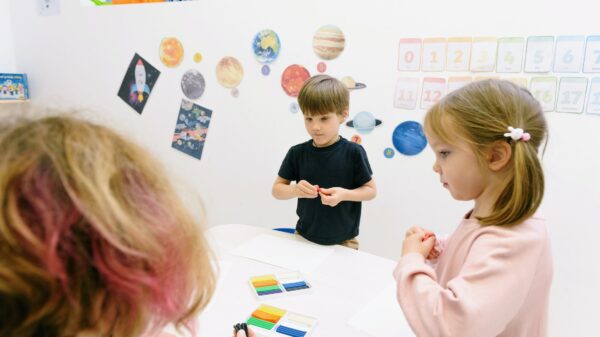Attention all lifelong learners, educators, and students! The future of education is here and it’s transforming the way we learn. From virtual classrooms to Artificial Intelligence (AI) tutors, technology has opened up endless possibilities for teaching and learning. But how exactly are these trends shaping education today? In this blog post, we will delve into the most exciting developments in educational technology that are revolutionizing the classroom experience. Join us on a journey exploring the latest trends and technologies that are changing the face of modern-day education as we know it!
Overview of Current Educational Trends
There are a number of current educational trends that are shaping learning today. Some of these include the rise of online learning, the increasing use of technology in classrooms, and the shifting focus towards student-centered learning.
Online learning is one of the most popular educational trends at the moment. More and more students are opting to take courses online, either through traditional colleges and universities or through specialized online schools. This trend is likely to continue as online learning becomes more accessible and affordable.
Technology is also playing an increasingly important role in education. Classrooms are becoming increasingly digitized, with laptops, tablets, and other devices becoming commonplace. And as digital resources become more sophisticated, they are being used more frequently in instruction. For example, teachers are using video conferencing to connect with distant classmates, and apps like Khan Academy are providing new ways for students to learn.
Finally, there is a shift happening in education towards student-centered learning. This means that instead of lectures and textbooks being the primary source of information, students are now expected to be actively engaged in their own learning. They are encouraged to explore different concepts on their own and find creative ways to apply what they’ve learned. This type of education is often referred to as “21st century learning” because it emphasizes skills like creativity, critical thinking, and collaboration – all skills that will be essential in the workplace of tomorrow.
Technology in Education
Technology is playing an increasingly important role in education. From online learning platforms to virtual reality, new technologies are giving students more ways to learn and engage with material. As these technologies become more commonplace, it’s important to understand how they can be used to improve education.
One of the most popular new technologies in education is online learning. Online learning platforms like Khan Academy and Coursera offer courses that can be taken at any time, from anywhere. This flexibility is ideal for busy adults who want to continue their education but can’t commit to a traditional classroom schedule.
Virtual reality is another technology that is starting to be used in education. VR headsets can transport students to different times and places, making history and science come alive. VR can also be used for hands-on learning experiences, such as surgery simulations. As VR becomes more affordable and widespread, it will likely be used more frequently in education.
Other technologies that are being used or developed for educational purposes include augmented reality, artificial intelligence, and 3D printing. These technologies have the potential to revolutionize education by making information more accessible and engaging.
Online and Distance Learning
The trend toward online and distance learning has been growing in recent years, as more and more people seek to obtain an education without attending a traditional brick-and-mortar school. There are many advantages to this type of learning, including the ability to study at your own pace, the flexibility to choose when and where you learn, and the lower cost of tuition.
However, there are also some challenges associated with online and distance learning. For example, it can be difficult to stay motivated when you’re not in a traditional classroom setting, and you may miss out on important social interactions with classmates and professors. Additionally, not all courses or programs are available online, so you may need to consider other options if your desired field of study is not offered virtually.
Despite these challenges, online and distance learning offer a great opportunity for those who want to obtain an education without attending a traditional school. With the right mindset and approach, you can successfully complete your coursework and earn your degree from the comfort of your own home.
Social Media and Education
The use of social media in education is one of the most talked-about topics in the education world. Some believe that social media can be a powerful tool for engaging students and promoting learning, while others are concerned about the potential negative effects of social media on young people.
There is no doubt that social media is having a major impact on the way we communicate and interact with each other. In fact, a recent study found that the average American spends more than two hours on social media every day. With such a large amount of time being spent on these platforms, it’s inevitable that they would also start to have an impact on education.
Some schools are already using social media to connect with students and promote learning. For example, many teachers are using Twitter to share resources and information with their students. Facebook groups are also being used to create online communities for classes and extracurricular activities.
While there are certainly some positive aspects to using social media in education, there are also some potential risks. One of the biggest concerns is the potential for cyberbullying. Another concern is that students may become too reliant on social media for information and miss out on important face-to-face interactions.
It’s important to remember that social media is just one tool that can be used in education. It’s up to educators to decide how best to use it in order to promote learning and engagement among their students.
Artificial Intelligence in Education
The education sector is under pressure as never before to evolve and meet the needs of an increasingly complex and competitive world. The traditional educational model – based on lectures, textbooks and exams – is no longer fit for purpose. In its place, a new model is emerging, one that is powered by technology and driven by data.
Artificial intelligence (AI) is at the forefront of this transformation. By harnessing the power of data and algorithms, AI is providing educators with insights that were previously hidden in mountains of paper records. It is also enabling the development of personalized learning experiences that cater to the individual needs of each student.
In short, AI is changing the way we learn. Here are five ways in which AI is shaping the future of education:
1. Smarter assessment: AI can help educators to design more effective assessment tools and identify areas where students need help. For example, IBM Watson Education’s Assessment Advisor tool uses AI to analyze data from student assessments and provide targeted recommendations to teachers.
2. Personalized learning: AI can be used to create personalized learning experiences for each student. By analyzing data such as learning style, interests and previous performance, AI-powered systems can select content and activities that are best suited to each individual.
3. Improved access to education: One of the biggest barriers to education is lack of access, particularly in developing countries. But AI-powered technologies are beginning to change this, by bringing educational resources to remote or
Virtual Reality & Augmented Reality
Virtual reality (VR) and augmented reality (AR) are two of the most talked-about technologies in education today. But what are they, and how can they be used in the classroom?
VR is a computer-generated simulation of a three-dimensional environment that can be interacted with in a seemingly real or physical way by a person using special electronic equipment, such as a helmet with a screen inside it. AR, on the other hand, is an enhanced version of reality created by adding computer-generated images to what the user is already seeing.
So how can these technologies be used in education? Here are some examples:
1. Field trips: Students can use VR headsets to take virtual field trips to places they might not otherwise be able to visit, such as ancient ruins or the bottom of the ocean.
2. STEM learning: VR and AR can be used to help students visualize complex concepts in science, technology, engineering, and math (STEM). For example, students might use VR to see how a cell functions or use AR to see how molecules interact with each other.
3. Language learning: VR and AR can provide immersive experiences that can help language learners practice their skills in realistic settings. For example, students could use VR to explore a virtual version of an Italian city or use AR to practice ordering food in Spanish at a restaurant.
4. Special needs: VR and AR can be used to create customized learning experiences for students
Cybersecurity, Privacy and Data Protection
There is no doubt that technology has transformed education in recent years. Online learning, distance learning, and blended learning are all now commonplace. But as education evolves, so too do the challenges faced by educators. One of the biggest challenges facing education today is cybersecurity, privacy and data protection.With more and more educational institutions storing data online, there is a greater risk of data breaches and cyber attacks. These can have devastating consequences for both students and staff. In order to protect data, educational institutions need to have robust security measures in place. This includes data encryption, firewalls, and access control measures.
Another challenge facing education is privacy. With the increase in online learning, there is a greater risk of student data being shared without consent. This can include personal information such as names, addresses, and contact details. Educational institutions need to have strict policies and procedures in place to ensure that student data is protected.
Finally, another challenge facing education is data protection. As more data is collected on students, there is a greater risk of this data being mishandled or misused. In order to protect student data, educational institutions need to have strong data management practices in place. This includes ensuring that only authorised personnel have access to student data and that this data is securely stored.
Robotics and Automation in Education
Robotics and automation are playing an increasingly important role in education. These technologies are helping to facilitate personalized learning experiences, by providing students with customized content and feedback. Additionally, robotics and automation are making it possible for students to interact with educational content in new and innovative ways. For example, robotic tutors can provide one-on-one instruction and feedback, while also freeing up educators to focus on other tasks. Automated grading systems can also provide immediate feedback to students, helping them to improve their understanding of concepts quickly.
Ultimately, these technologies have the potential to greatly improve the educational experience for all learners. By facilitating personalized learning experiences and providing immediate feedback, they can help students learn more effectively and efficiently. Additionally, they can free up educators to focus on other aspects of their job, such as developing relationships with students or planning lessons. As these technologies continue to develop and become more widely used, it is likely that they will have a transformative effect on education.
Conclusion
We have seen how technology and trends are shaping the future of education today. With so many tools and resources available, educators can now create an engaging learning environment that meets their students’ needs while also helping them develop skills they will need throughout life. By staying up to date with the latest trends and technologies, teachers can ensure that their students are getting the best educational experience possible.










